The highlight of any visit to Siem Reap has to be the Angkor Wat. Renowned throughout the world, this temple complex is the icon of Cambodia and is the main symbol of the national flag.
The Angkor Wat is located inside an amazing rectangular man-made island - surrounded by a moat and in the midst of lush greeneries. Like most ancient temples in Siem Reap, it started as a Hindu complex and was later overtaken by Buddhist influences. The whole place was built on a east-west orientation. There were 2 entrances across the moat. The front entrance was at the western side.
Chet, our guide picked us at our hotel on the second day of our holiday. He brought us the eastern side, entering the complex through the rear entrance. He said he preferred to show his guests from the back. He did not say why, perhaps saving the best for last. There was a small temple ruin at the rear entrance. It was a prelude to the grandeur that was to come.
We explored this small temple ruin.
And then walked down a path through a kind of secondary forest - surrounded by tall beautiful trees. The birds were very active that morning, perhaps cheering at the unexpected sunshine.
We emerged from the "forest" to a most spectacular sight. It was the mighty Angkor Wat viewed from the its "backyard". What a glorious sight and what a glorious day.
Naga, the dragon snake made his presence felt here.
The backyard of the Wat was quiet and peaceful. Most visitors enter from the front and not many of them explore this part of the complex.
It gave us the opportunity to admire the intricate wall carvings up close.
We climbed a flight of wooden steps to enter the inner sanctum of the temple.
Inside, it was a hive of activities. The crowd that had entered from the front was all there.
The architecture and art work were astonishing. The Angkor Wat was declared an UNESCO World Heritage site in 1992.
We paid a US dollar to pose with these models in traditional Cambodian and mythical costumes.
We then climbed a steep wooden stairs to the upper level of the temple. Climbing up was relatively easy. Climbing down was a lot more tricky. We hung to dear life on the handrail.
Chet told us these wooden stairs were built only about 2 years ago for the convenience of visitors. Before that, tourists would have to negotiate up these steep narrow steps as how the ancient people did. Each step was only about half a foot-length wide and there was no hand rail for support.
Up in the top level of he temple, we had a panoramic view of the whole temple complex..
The original Hindu carvings on the wall.
Present day Buddhism.
Almost all the Buddha statues in the temple were without the heads. In the French colonial period and during the wars, the statues were rampantly vandalised. The heads were stolen to be sold in the international markets at very lucrative prices. What a crying shame. They are now irreplaceable.
We were curious to see holes on a lot of the rock slabs in the temple complex. Chet told us that the rocks used to build the Angkor Watt came from the hills about 80 km away. They were dragged here by elephants. These were peg holes to facilitate the transportation.
After we descended from the upper level, we proceeded to the front of the temple.
There was a group of Buddhist devotees in the midst of their prayers.
The front court yard was large and beautiful.
This view of the Angkor Wat was from the western front. This was where most people come to view the sunrise from the east. Apparently the reflection of the sun behind Angkor Wat on the lake is a very beautiful sight.
As we walked on, we were again mobbed by some kids selling their wares. They were hardly 4 or 5 years old, walking around without shoes. Joyce very kindly distributed some candies to them.
We exited the Angkor Wat along this narrow causeway across the moat.
Our driver was there to pick us. He drove us to this nearby restaurant for lunch.
Chet and our driver joined us for the meal. Being local and familiar, he did the ordering.
A fresh coconut was the perfect thirst quencher after a hot morning adventure.
I won't attempt to describe too much in detail of the food we ate. This was a vege dish with some cashew nuts.
Cambodian pork curry served in a coconut.
A vegetable soup.
A beef dish. When I took this picture, some hungry one had already dug a hole on it.
A kangkong dish, not unlike what we have in Malaysia. They call it morning glory.
Finally a fish dish - kind of sweet and sour flavour.
Over all, it was not a fantastic meal. The flavour was most ordinary. The dishes were very small. Chet definitely under-ordered. The food for the 6 of us was hardly enough.
After lunch, Chet brought us to yet another temple ruins. This was Angkor Thom. It was just a short drive from Angkor Wat.
Angkor Thom was a small city by itself. It is located in a 9 sq km site, surround by a wall and a moat. It was built by King Jayavarman VII in the late 12th century. This was one of the entrances into the city.
Our visit to Angkor Thom centred mainly in the temple ruins. The temple was characterised by the many smiling statues. Many people mistake these to be the smiling faces of Buddha. However, like most ancient temples, Angkor Thom was built a Hindu shrine. Buddhism came much later.
We explored the temple ruins. Compared to the Angkor Wat, this was a small temple.
After Angkor Thom, we returned to the hotel for a rest. This was meant to be a light and easy holiday. We didn't want to push ourselves. In the hotel lobby, we tried our hands on the roneat - a traditional Cambodian musical instrument.
That evening, our dinner was in a small restaurant in down town. It was raining and we couldn't explore too much for a good eating place. And we wanted a local Cambodian meal. So we settle for this gaudily lighted place known as Khmer Kitchen.
The waiter who took our order spoke good English. He was pleasant and polite but was not very much of a help in our quest for some authentic Cambodian dishes.
Our starter was some fresh spring rolls. They did not turn out as depicted in the menu. They came with a bowl of sweet peanut sauce. In the rolls were mainly vegetables. The flavour was just so-so.
Next was a mango salad. The flavour was sweet sour. The mango was in strips - quite like the Thai equivalent. I liked the dish.
The Cambodian curry was a very poor imitation of what curry should be. There was a choice of meats. I think we opted for pork. In it were potato, yam, pumpkin and carrot - thus the mushy texture. There was no flavour of curry at all. More like an olio stew.
We had 2 portions of deep fried pork ribs. They were good. The ribs were marinated in a very aromatic sauce before they were fried to a golden brown. They were served with a chilli sauce.
This was "Deep-fry fish with Powder" - translated to mean deep fried fish in a batter. The fish was from the lake (Lake Tonle Sap, which we would visit the next day). The fish was dry and bland. There was almost no flavour in the batter. We struggled to finish it.
Our last dish was perhaps the only genuine Cambodian dish we had that evening. It was known as Prahok Kateas. Prahok is a salted and fermented fish paste. It was cooked with pork in coconut milk, and served with some raw vegetables. The flavour was very much like our cincalok. It was strong and salty and we couldn't eat too much of it on its own. But it went very well with rice. I enjoyed this dish.
The dinner ended an interesting yet relaxing day. After that, the ladies walked across the road and bought so many scarfs like there were no scarfs in Malaysia.
And then we returned to the hotel for the night. The next day would be another eventful one.

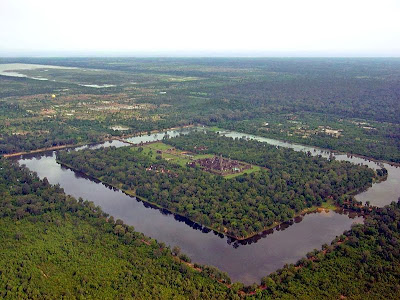



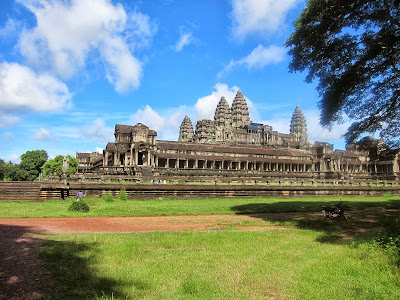





















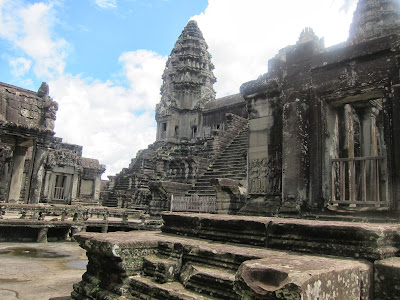







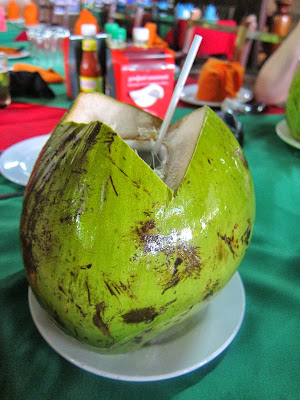












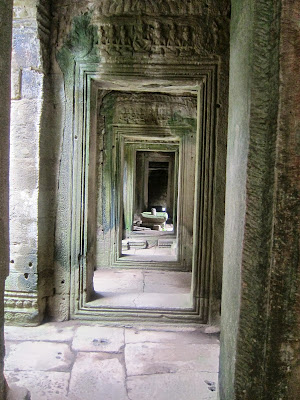







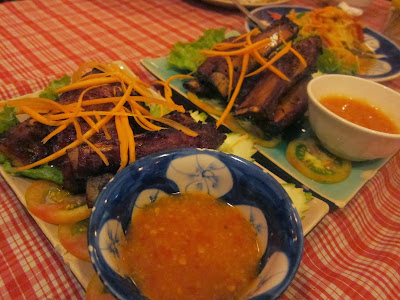



No comments:
Post a Comment